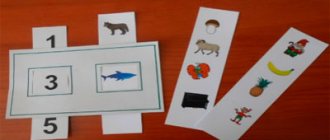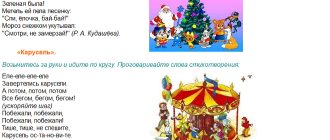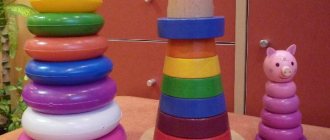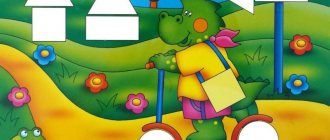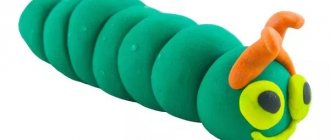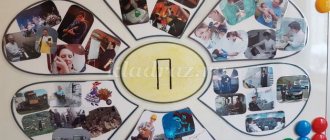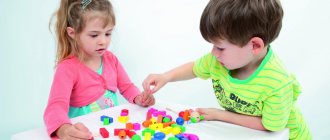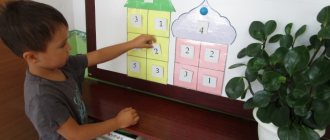Match items by color
The collective game “Select objects by color” helps to memorize the names of the main tones of the palette - brown, red, orange, yellow, green, blue, purple, gray, black, white (you can use all or several of the above).
The lesson develops:
- memory, thinking, attentiveness;
- speech skills;
- perseverance, diligence;
- the ability to visually perceive objects;
- motor skills of fingers;
- culture of collective behavior.
For the game, you need to prepare cardboard sheets painted in the selected colors, and cards depicting animals, plants, fruits, and things of appropriate shades.
The teacher lays out cardboard on the table. Pupils take turns taking the illustration they like, saying what it depicts and what color the object is drawn. Place the card on the corresponding cardboard sheet.
Children can be divided into groups according to the number of sheets of cardboard. Participants must take only those cards that match the color of the group.
Didactic games to develop children's ideas about the color of an object
Target:
- teach to distinguish and name the primary and tint colors of an object; learn to group objects by color;
- develop the ability to analyze, compare and classify.
“Find objects of the same color”
The teacher hands out cards to the children with various images of red, blue, yellow, and green on them. Having determined what color the image on the card is, children come to the table and select figures of a given color and name the color.
“Name the color of the object”
The teacher offers to determine the color of the toy, vegetables, etc.
"Arrange objects by color"
The teacher lays out a didactic set for free play (mosaics, cubes) and encourages the children to name the colors. After this, the children organize the material by color.
"Balloons"
The child is offered a card with a picture of multi-colored strings and a set of circles - balls. You need to “tie” the balls to threads of a suitable color.
Fun Train
The child is offered a card with a picture of a train. A reference card with a picture of a color is placed in the train. The child selects figures of the same color and “seats” them in the trailers.
"Find a tea pair"
The teacher hands out colorful tea cups to the children. There are saucers of matching colors on the tables. Children are asked to find a tea pair - match the color of the cup and saucer.
“Where did Snow White go wrong?”
The teacher arranges tea pairs by color and at the same time makes a mistake and says: “Guests should come to Snow White. She was in a hurry and made a mistake when arranging the tea pairs. Help Snow White arrange the tea utensils by color correctly.”
"The cars are going home"
Children have cards with pictures of multi-colored cars. On the table there are cards with pictures of garages of different colors. The teacher invites the child to find his own garage for each car.
"The car got lost"
The teacher arranges all the cards in pairs, but makes a mistake and invites the child to find for himself which car “drove” into the wrong garage - a garage of a different color.
"For repairs"
The teacher puts all the cars in a row and then removes one. The child must remember which color car is missing.
"Colors"
Option 1.
Select 3 game elements so that 2 of them form a common pair. Invite your child to combine matching elements into one card. At the same time, he must name the color of the pencil shown. Invite your child to then independently assemble the remaining elements into cards.
Option2.
All halves of cards with images of objects are first placed face up in the center of the table, then turned over. Elements with the image of pencils are divided equally between the players. The right to move first is determined by drawing lots or counting. The player who has the right to move takes one of the elements from the table, names what color the item is depicted in, and keeps it if he has the second element of the card with the image of a pencil. The test is the Puzzle lock, which is different for each pair of elements. If there is no suitable half, the element is mixed with those remaining on the table, and the next player gets the right to move. The one who collects his cards first wins.
"Settled home"
(didactic game “Big - Small”)
Place the cards face up in front of your child.
Tell a fairy tale, for example this one.
In one fairy-tale country, all objects of the same color became such strong friends with each other that they decided to live on the same street in a house of the same color. And in order for brothers and sisters - big and small - to live on the same floor, they need to be immediately connected in pairs.
Invite your child to take turns building houses whose pictures on the cards are the same color as the roof. The result will be the following houses: red - 5-story; brown - 3-storey; yellow - 3-story; blue - 2-story; green 2-storey.
When the houses are built, ask the child to count how many floors are in the red house, how many in the green, how many in the blue, etc., named, and show the corresponding numbers.
Ask the child who lives or what is located, for example, on the second floor of a green house or on a brown one, etc. Ask the child to show the highest and lowest floor, to find houses that are the same in height. Let him tell you how many floors there are and what color the roof is.
"Colorful glades"
The child is offered a playing field - a clearing, divided into multi-colored squares and silhouette images of toys, flowers of different colors. In the clearing, you can place objects of the same color on the corresponding squares.
“What did the artist paint incorrectly?”
The teacher offers the children fruits and vegetables that the artist has painted. Children must find what the artist painted incorrectly and name the correct color of the object.
"Assemble the train by color"
(didactic game “Locomotive for Animals”)
On the table there are cards with images of 6 multi-colored trains and carriage cards with images of insects, fish, birds, and a house. And wild animals. The teacher suggests matching the train with carriages with passengers of the same color and placing them in a row.
Didactic games with geometric figures of Dienesh:
- “Find all the shapes like this one” (by color)
- “Find a figure not like this one” (by color)
Informational resources:
1. Z.A. Mikhailova, E.N. Ioffe “Mathematics from 3 to 7”, St. Petersburg, Detstvo-Press, 2001.
2. Z.A. Mikhailova, I.N. Cheplashkina, “Mathematics is interesting”, St. Petersburg, Detstvo-Press, 2004.
3. D. Alhaus, E. Doum “Color, shape, quantity”, Moscow, Education, 1984
4. B.P. Nikitin “Steps of creativity or educational games”, Moscow, Education, 1991.
Place flowers in a vase
This version of the “Match by Color” game reinforces the idea of three basic tones - blue, red, yellow.
Lesson objectives:
- formation of cognitive and analytical abilities;
- improving finger motor skills;
- fostering perseverance, diligence, and the ability to work productively in a team;
- development of speech, expansion of vocabulary by including words related to the tones of the palette;
- improving the ability to visually perceive objects.
For the didactic game, you need to cut out three vases and many flowers of three corresponding colors from cardboard. The teacher places vases on the table and puts the flowers into piles according to color. Gives the children the task of choosing the correct group of flowers for each vase.
You can complicate the task to develop logic and attentiveness, mix the flowers in one pile. Pupils must correctly distribute the flowers among the vases.
Didactic games and exercises on color science
Goal: to clarify children’s ideas about different genres of painting: landscape, portrait, still life. Material: reproductions of paintings. Game description: 1 option. The teacher suggests looking carefully at the paintings and putting paintings depicting only a still life (or only a portrait, landscape) in the center of the table, putting others aside. Option 2. Each child has a reproduction of a painting, some of them depict a landscape, some have a portrait or a still life. The teacher asks riddles, and the children must show the answers using reproductions of paintings.
If you see in the picture a river is drawn, Or a spruce and white frost, Or a garden and clouds, Or a snowy plain, Or a field and a hut, The picture must be called... (landscape) If you see in the picture a Cup of coffee on the table, Or fruit juice in a large decanter, Or a rose in crystal, Or a bronze vase, Or a pear, or a cake, Or all the objects at once, Know what it is... (still life)
If you see someone looking at us from a painting - Or a prince in an old cloak, Or a steeplejack in a robe, A pilot, or a ballerina, Or Kolka, your neighbor, The painting is definitely called... (portrait). Didactic game “Make a still life”
Goal: to consolidate knowledge about the genre of still life, to teach how to compose a composition according to your own plan, according to a given plot (festive, with fruits and flowers, with dishes and vegetables, etc.) Material: various pictures depicting flowers, dishes, vegetables, fruits, berries, mushrooms or real objects (dishes, fabrics, flowers, dummies of fruits, vegetables, decorative objects) Description of the game: the teacher invites children to create a composition from the proposed pictures, or to create a composition on the table from real objects, using various fabrics for the background.
Didactic game “Correct the mistake”
Purpose: to teach children to listen and look carefully, to detect and correct mistakes.
Material: reproductions of paintings. Description of the game: the teacher, in an art history story, describes the content of the work and the means of expression used by the artist, explains what mood the artist wanted to convey in his work, but at the same time deliberately makes a mistake in describing the picture. Before starting the game, children are given the instruction to watch and listen carefully, as a mistake will be made in the story. Rules. Listen and watch carefully, detect and correct errors. The winner is the one who identified the most errors and corrected them correctly. He also gets the right to be the leader in the game - to compose an art history story based on another work. An approximate art history story by a teacher (with intentional errors) based on the painting “Haymaking” by A.A. Plastova: “You see a reproduction of a painting by A.A. Plastov “Summer” (wrong in the title). She talks about how, on a hot, clear day, mowers - old men and women - came out into a meadow covered with green, emerald grass (there is no description of the flowers) (the image of a teenager is missing in the description). The most important and beautiful thing in this picture are the white-trunked birches; they are painted in the center of the picture (an erroneous description of the compositional center). The work conveys peace and quiet joy. To do this, the artist uses bright, rich colors: yellow, green, blue, red.” Didactic game “Guess the picture” (word game)
Purpose: to teach children to find a picture using a verbal description.
Material: reproduction of a painting. Game description: 1 option. The teacher describes a painting by an artist without naming it or telling what colors the artist used. For example: “There is a girl sitting at the table in the room. She has a dreamy face. There is fruit on the table. It’s a summer day outside.” Children tell what colors and shades are used to depict everything that the teacher talked about. Then the teacher shows a reproduction of the painting to the children. The one whose answer is closest to the truth wins. Option 2. To the music, the teacher describes in detail a landscape. Then he shows the children reproductions of paintings of different landscapes, among which is the one he described. Children must recognize the landscape from the description and explain their choice. Didactic game “What does a landscape consist of?”
Purpose: to consolidate knowledge about the genre of landscape, its distinctive and constituent features and parts.
Material: various pictures depicting elements of living and inanimate nature, objects, etc. Description of the game: the teacher offers children a variety of pictures. Children must select only those pictures that depict elements inherent in the landscape genre, justifying their choice. Didactic game “Find the flaw in the portrait”
Goal: To consolidate knowledge about the components of the face: forehead, hair, eyebrows, eyelids, eyelashes, eyes, pupil, nose, nostrils, cheeks, cheekbones, mouth, lips, chin, ears.
Material: 10 cards depicting one person with different flaws. Description of the game: the teacher invites the children to look at the picture and identify the missing parts of the face in the picture and tell what function they perform. Didactic game “Assemble a landscape”
Purpose: To consolidate knowledge about the constituent elements of a landscape, about the signs of the seasons, to learn to compose a composition according to one’s own plan, according to a given plot (autumn, summer, spring, winter). Material: Colored images of trees, flowers, herbs, mushrooms, etc., reflecting seasonal changes in nature. Description of the game: children need to use color images to create a landscape according to their own ideas or according to the plot given by the teacher.
Multi-colored balls
The didactic game “Match balls by color” reinforces ideas about the basic tones of the palette and develops the ability to correlate objects by shade. The exercise promotes speech development and attentiveness.
To play, you need a picture depicting a boy or girl with multi-colored ropes in his hand. You need to cut out balloons of the appropriate colors from cardboard.
The teacher, pointing to the picture, explains that the balloons came off and flew away. The task of preschoolers is to find the balloons that have flown away and correctly attach them to the ropes.
Didactic games aimed at developing color perception
DIDACTIC GAMES AIMED AT DEVELOPMENT
COLOR PERCEPTION
Gifts for Fairies
Option
I Purpose.
Reinforce ideas about colors. Teach children to highlight colors, distracting from other characteristics of objects (shape, size, functionality)
Material.
Fairy dolls of different colors and shades. Toys and objects of different colors.
Children are invited to give a gift to the Flower Fairy. only the same color as the fairy herself.
At the initial stages, one fairy doll of a certain color is used.
Option
II Purpose.
Reinforce ideas about colors. Teach children to highlight colors, distracting from other characteristics of objects (shape, size, functionality)
Material.
Fairy dolls of different colors and shades cards - “rugs”, two or three geometric figures of each color of different shapes and sizes (different materials are used).
Children are invited to give gifts to the Colored Fairies. Hand out colored “tickets”, name the color, shape, size.
Find a flower of the same color
Target.
Teach children consistent visual examination and description of an object, its shape, indicating proportions, color, shade.
Material.
Typesetting canvas. Flowers of different colors, shades and sizes.
Place a butterfly on a flower of the desired color
Target
. Teach children consistent visual examination and description of an object, its shape, indicating proportions, color, shade.
Material
. Typesetting canvas. Flowers of different colors, shades and sizes. Butterflies.
The teacher names the flower or describes its distinctive features. He offers to find it and plant a butterfly on this flower.
Collect a seven-flowered flower
Target.
To consolidate children's knowledge about the relationship between the colors of the spectrum.
Material.
Green typesetting canvas. Heart petals 7 colors, 4 pieces of each color.
Find two identical hearts
Target.
To consolidate children's knowledge about the relationship between the colors of the spectrum. Learn to correlate objects by size and color.
Material.
Green typesetting canvas. Heart petals of different colors and flower sizes, 2 pcs of each color.
Sunbug
Target.
Introduce children to colors and shades and their names. Learn to compare objects by color by placing them next to each other.
Material.
Flowers with 6 petals of different shades - blue, green, red, 1 flower with multi-colored petals. The sun bugs are the same shade as each of the petals.
Choose an item by color
Target.
Exercise children in matching and grouping objects by color.
Material.
I
option.
Puzzle cards with colored objects and center squares in 6 primary colors.
II
.
Puzzle cards with colored objects and middle puzzles of primary colors and shades.
Children choose the middle of the puzzle of any color they like and select cards of the corresponding color.
Warm and cool colors
Purpose.
Reinforce the idea of grouping the colors of the spectrum into warm and cold.
Material.
Picture of the sun and snowflakes, circles of different colors of the spectrum and their shades.
Children are asked to identify the colors that suit the sun and those that suit the snowflake, and explain their choice.
Choose a palette
Target.
Teach children to find the color palette in which the picture was created.
Material.
Picture cards made in different colors and genres. Palette cards.
Children choose a large card with an image and from the palette cards select the one that matches the image. (For convenience, the same numbers are glued on the back side - the number on the card and the number on the palette correspond to each other).
The game can be played as a competition: who can choose the most correct palettes for the pictures.
Make a Dymkovo pattern
Target.
Teach children to make a pattern based on Dymkovo painting.
Material.
Elements of Dymkovo painting carved from dish sponge.
I'll be the hairdresser
Target.
To develop children's ability to trace patterns and complete drawing and cutting out the “hairstyle”.
Material.
Portrait templates, colored paper of different shades and formats, simple pencils, scissors.
Children model their hair using a portrait template.
Collect a flower
Target.
Practice the ability to select halves of one flower in accordance with color and shade.
Material.
Half cards featuring flowers, varying in color and style.
From the proposed set of cards, children make a flower. When all the flowers have been collected, children are asked to combine the cards into groups according to the style of the flower image.
Choose a vase for a flower
Target.
To develop color perception in children - the ability to distinguish up to five shades of the same color, and to correlate these shades with each other.
Material.
Cards, five shades of the same color, with flowers and pots.
Make a picture from geometric shapes
Target.
Teach children to make silhouette figures using geometric shapes. Develop imagination. Fix the names of the primary colors.
Material.
Sample cards, a set of geometric shapes of different colors and sizes.
Columbus egg
Target.
Teach children to make silhouette figures using all the parts, attaching one to the other, without overlapping one on top of the other. Develop sensory abilities, spatial representations, and integrity of perception.
Material.
An oval measuring 15x12cm, cut into 9 parts: 3 triangles (2 large, 1 small), 2 figures similar to a quadrangle, one of which is round, 4 figures (large and small), similar to a triangle, but with one side rounded. To make the game, we used cardboard, identically colored on one side and multi-colored on the other. Sample cards.
At the initial stage, children find similarities between the shapes of game elements and real objects.
Next, children are asked to create a silhouette figure according to the proposed model.
When children have mastered the techniques: they independently invent and make figures.
Tangram
Target.
To train children in the ability to compose new images from existing geometric shapes, based on a model and according to plan.
Material.
A square of cardboard, painted on one side with one color and multi-colored on the other, cut into 7 parts: 2 large, 1 medium, 2 small triangles, a square and a parallelogram.
Caterpillar
The didactic game reinforces the idea of the main colors - red, yellow, green, blue.
The lesson promotes:
- the desire for knowledge;
- development of speech skills;
- formation of analytical ability and logic;
- development of attentiveness, perseverance, independence;
- gaining the ability to work with templates.
The activity requires four illustrations of caterpillars as empty circles with painted heads, as well as four colored circles of the appropriate diameter.
Children must make caterpillars from circles, guided by the color of their heads.
For older children, you can complicate the task: cut out circles of light-dark or warm-cold tones, ask them to arrange the caterpillars from beginning to end.
Introducing young children to color through educational games
The game develops intelligence, resourcefulness, and initiative.
Nadezhda Konstantinovna Krupskaya
Play is a need of a growing child's body. How can we help children learn what makes educational games unique? Before starting work on introducing preschoolers to educational games at an early age, I set the following goal:
Systematize material about didactic games available for learning by preschool children, using various forms of work .
I started getting acquainted with didactic games by solving a set of problems that realize the set goal:
Teach children to focus on the shape of objects, to use the simplest techniques for establishing the identity and difference of objects in shape, focusing on the words “shape”, “such”, “not such”, “different”, “same”.
Learn to perform simple actions with objects: remove and string rings.
Learn to perform simple actions with objects that vary in size, focus on the words: “open”, “close”, “big”, “small”, “like this”, “not like this”.
Strengthen children’s ability to compare objects by size, choosing from two sizes of the same shape.
Teach children to choose objects of two given colors from four possible ones, consolidate the ability to group objects by color, and familiarize them with the sequence of placement of color tones in the spectrum.
To achieve the goals and objectives, I began work in the following directions:
systematization of material about didactic games available for learning by young children, using a variety of working methods;
replenishment of the development environment;
- involvement and activation of parents in the sensory education of the baby.
The main principles of my work to familiarize preschoolers with educational games are:
taking into account age characteristics when selecting content and topics of classes;
- creation of emotional and psychological comfort;
- respect for the personality of each child.
Forms of work to familiarize children with didactic games:
- occupation;
- reading fiction;
examination of color paintings and pictures;
color plan - map;
colorless plan - map;
productive activities (drawing, modeling, designing);
- making and guessing riddles;
card index of didactic games;
joint work with parents;
mini-museum of M. Montessori.
At the same time, she replenished the development environment with the necessary items and aids, attributes for games, illustrative and demonstration materials.
Children began to get acquainted with didactic toys at a young age. Sensory education is aimed at teaching children the ability to accurately and fully perceive objects, their various properties and relationships (color, shape, location in space). Observing the kids in the group, I became convinced that knowledge acquired verbally, and not supported by sensory experience, is unclear and indistinct. Without enriched sensory experience, children develop the most fantastic ideas about the surrounding reality. All objects and phenomena have a complex of properties (size, color, shape). To get acquainted with an object, you need to fill in the properties that characterize it. The child, perceiving, identifies some properties and signs, but usually these are the ones that involuntarily catch the eye. Therefore, I set myself the task: to teach children to identify the most significant, characteristic things in objects and phenomena, to form in children an idea of sensory standards.
At the beginning of the year, I diagnosed children to distinguish colors and color shades. I found out that only a small part of them could distinguish primary colors. During the games, she taught children to solve simple mental problems such as: put two objects of the same color next to each other, based on a colored plan map, and name them correctly.
The work was carried out in stages. She developed the children's memory, attention, logical thinking, and color perception. For this purpose, she offered didactic games: “Pick it right”, “Balloons”. The didactic material aroused great interest in the children and a desire to act. The kids exchanged objects, compared them, made conclusions: “Same ball”, “same stick”, “Fish of the same color”, “Matryoshka dolls of different colors”. Of course, not all children coped with the task. Some of them could not match the cars, balls, and sticks based on color. I tried to use a variety of teaching materials and homemade games. For example, placing mushrooms of two colors when choosing from 4, they enthusiastically examined the mushrooms, compared them, and matched them to the standard.
Taking into account the peculiarities of children’s perception of color, I first used chromatic colors: red, yellow, blue, green, and then achromatic ones: black and white. In difficult cases, I turned to the color plan. I tried to select toys and objects with intense colors. Preschoolers learned the simplest mental operations, namely, to compare and contrast colors. The main task of didactic games is that the task is presented to the child in a playful form. In the process of didactic games, children master the skills of operating with certain objects and learn the culture of communication with each other. Any didactic game contains cognitive and educational components, game actions, game and organizational relationships.
The children’s knowledge acquired in didactic games was consolidated during developmental games that their parents helped make. These games are a set of logical tasks of increasing difficulty. When completing the task, she gave the kids independence. At first, when introducing children to games, I paid special attention to the color map plan and supported them with emotional remarks. This inspired the children and gave them hope in their capabilities. The children diligently put together path patterns according to the graphic image from cubes, which were painted red, blue, yellow, and green. Children who completed the task were given a car of the same color as the track to play on. The game aroused great interest among children.
Along with didactic toys, I also used printed board games “Loto”, “Colors”, “In the World of Fairy Tales”, “Our Garden” - insert frames. In them, the children matched small cards with depicted objects to large cards based on verbal content. Small cards and large cards connected to each other had the same color background.
The board game “Mosaic” develops mental abilities, logical thinking, and the perception of chromatic colors well. Children love to play this game in the afternoon and morning.
To conduct didactic games during classes and outside classes, aimed at the perception of chromatic and achromatic colors, mental abilities, she developed, produced and systematized the following didactic aids: ladybugs of large and small sizes, didactic rugs “Merry Glade”, “Whether in the Garden, in vegetable garden”, wall rug “In a sunny meadow”, “Let’s decorate our Christmas tree”, “Flower - seven flowers”.
Children began familiarizing themselves with shape later than familiarizing themselves with color. She taught children to play “Color Lotto” - fill out cards with color fields of three types of geometric shapes, matching them by color. I was preparing a color plan - large cards with three white fields. On one field the outline of a circle is drawn, on the other - a square, on the third - a triangle - a colorless plan. They are the same size as smaller geometric shapes of different colors. At the beginning of the game, I was given a task: to look for figures of the same shape as those drawn on the cards. She explained that a circle has no corners and is smooth, but a triangle has sharp corners. I asked the children to trace the outline of each figure with their finger. She taught me to superimpose each selected figure onto a contour image and make sure they match. Next time I gave large figurines. In this game situation, applying will not help; you need to solve the problem by eye. I complicated the version of this game - with five figures (added an oval, a rectangle). Next, the children matched the models with figurines of five shapes of real objects.
At the same time, I begin to become familiar with size by becoming familiar with color. Children built towers from three same-color cubes, significantly different in size.
In my work I pay great attention to the sensory materials of M. Montessori. Games, activities, exercises with didactic materials allow you to develop visual and distinctive perception of sizes, shapes, colors, recognize sounds, and contribute to the development of speech. Didactic material is constantly being improved in practice - these are frameworks - inserts. The child learns to relate the shape to the slots.
The combination of visual perception and muscular-tactical perception was used in games with cards (color plan). The child, at my request, applied a certain shape drawn on the card so that they completely coincided. To perceive the chromatic feeling, I use lacing, fasteners, and braiding with multi-colored laces. I move from bright colors to shades.
To recognize shades of noise, I use boxes covered in different colors and filled with more or less natural material. Shaking them makes noise. Children especially love to play with multi-colored gauze handkerchiefs: they throw them up, catch them with both hands, dance, name the colors of the gauze handkerchiefs.
To consolidate the knowledge acquired in kindergarten by preschoolers, she simultaneously worked with parents. Introducing children to didactic games in young children can only be effective if parents are actively involved. I designed wall newspapers, a mobile folder, and prepared consultations on “Education of sensory culture in children two to three years old”, “The role of didactic toys in the intellectual development of young children” and others. She also involved parents in organizing children’s productive activities, since one child cannot cope with this activity. She offered the children a task, which they completed together with their parents (draw a New Year tree, sculpt silhouettes of Christmas trees on cardboard, using plasticine of different colors).
To consolidate knowledge about didactic games, color and shape, I thought through and organized the subject environment in the group. She created a mini-museum of didactic games based on M. Montessori.
The collective work of children with parents and teachers gave them the opportunity to express themselves in various types of role-playing activities, contributed to the development of communication skills, creativity and independence. Children learned to perceive the color of specific objects, using the acquired ideas about chromatic and achromatic colors, and later - about their shades, and developed the ability to recognize the corresponding shape, name it and act with it.
Literature:
- Wenger L. A. Raising a child’s sensory culture from birth to 6 years. / L. A. Wenger, E. G. Pilyugina, N. B. Wenger. - M.: Education, 1988. - 144 p.
- Zvorygina, E.V., Didactic games and activities with young children // E.V. Zvorygina, N.S. Karpinskaya, I.M. Kononova. - M.: Education, 1985. — 144 p.
- Pavlova L. N. Early childhood: development of speech and thinking. / L. N. Pavlova. - M.: Mozaika-Sintez, 2000. - 168 p.
